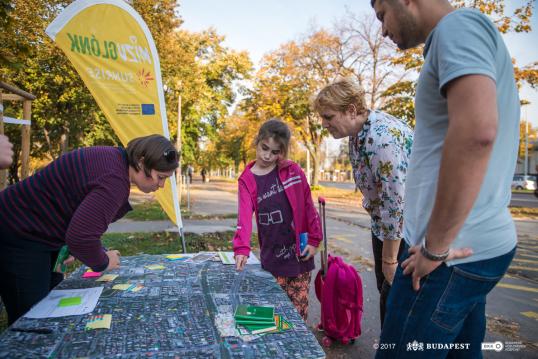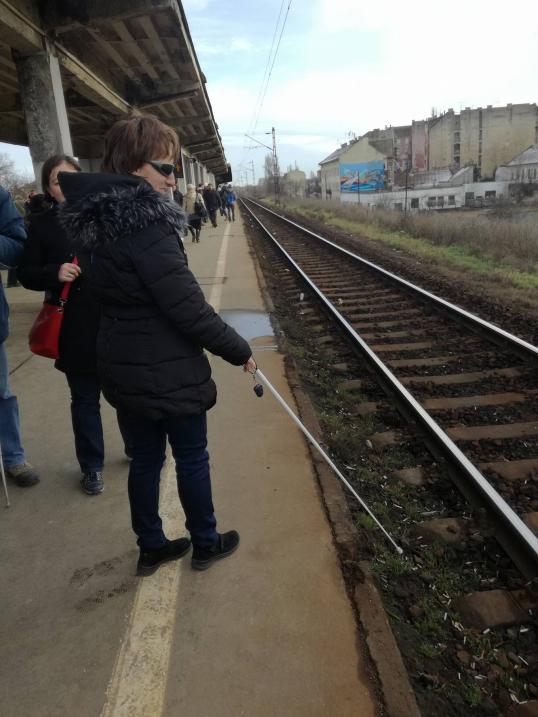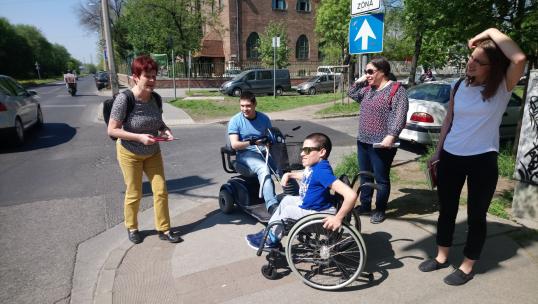- Topic
- Policy and research
- Transport for people with reduced mobility
- Country
- Hungary
- Resource type
- Case study
First published on 20 March 2023.
This case study is based on the activities conducted in Zugló, a neighbourhood in the XIV. district of Budapest, within the CIVITAS SUNRISE project.
The objectives of this case study are to:
- emphasise the importance of co-creation in the planning, implementation and evaluation of sustainable mobility measures created for, and with, citizens at the district level;
- assess the transferability potential of the good practices tested within the project to other neighbourhoods across Europe and worldwide.
Context
All SUNRISE cities already have city-wide mobility strategies (SUMPs), yet they realise that a large potential for innovation remains untapped at the neighbourhood level. To untap this potential, it requires the proactive involvement of local communities, stakeholders and residents for their insights on novel, creative, lasting and publicly agreed solutions to what they perceive as pressing urban mobility challenges.
The neighbourhood in which the case study is focussed on, Törökőr, is situated in Zugló, which is one of the 23 districts of Budapest, located in the transitional zone between the core and the outskirts of the city. Törökőr has a population of 12,045 inhabitants and is 1.75 km². It is an economically strong area of the Budapest Functional Urban Area, which has higher economic indicators than the Hungarian and EU average and a high potential for further economic development.
The SUNRISE participatory planning process in Zugló-Törökőr was seen as an opportunity to test various participation formats with the local community, with the goal of integrating successful formats in the municipal planning processes beyond the project lifetime.
In action
The SUNRISE methodology facilitated the identification of ‘mobility problems’ with the involvement of the community. The framework of the SUNRISE co-creation process followed a stepwise approach consisting of four steps based on collaborative principles:
- Problem identification concluded with a SWOT analysis;
- Solutions design;
- Measure selection based on an ex-ante evaluation process;
- Implementation of validated solutions including impact assessment (ex-post evaluation).
Different formats (online and offline) were used in this process, such as stands put up in busy areas of the neighbourhood and different events with citizens. A broad range of formats were tested in the co-identification of problems and co-validation of needs phase, such as workshops, a neighbourhood festival, an online presence through a dedicated website and a social media Facebook channel, a walking tour for problem mapping and online problem mapping, an online and offline questionnaire, physical information points, and thematic walks.
The entire set of activities in the neighbourhood was made possible by the voluntary action of residents who, from the start of the project, formed a Core Group (CG) that actively organised the SUNRISE process in the neighbourhood. The CG officially consisted of 10 people as of 06/04/2018 (those who had signed the Declaration of Membership). Nine of these were local residents and one represented a local business.
The group remains functional today even after the project closed in order to further take up the activities that were started during the project and work further on improving urban mobility at the neighbourhood level. Thus, the SUNRISE project has started a ‘co-creation’ movement around its action neighbourhoods and has managed to shape a certain pro-active attitude among residents. Using the SUNRISE process, an actual sustainable mobility action plan for the neighbourhood was developed following the main participation and cooperation principles that are laying the foundation of integrated mobility planning in cities.
Results
The main results of the co-creation process in Törökőr were a thorough identification of problems through a SWOT analysis. The result of the analysis fed into a strategy which identified the opportunities to reduce the weaknesses in the local mobility system. The three main strategic directions identified in the strategy focused on:
- Using the stronger bicycle culture to develop cycling infrastructure;
- Looking at the adequacy of the infrastructure designed with vulnerable groups in mind, not least because the Institute of Blind People is based in Zugló;
- Using sharing systems to make the mobility system more sustainable.
Based on these findings, a set of seven options were identified, which were comprised of different measures taken up by the municipality:
- Traffic calming measures in residential streets;
- Solutions for the high demand for parking;
- School mobility;
- Solutions for improving the safety of pedestrian crossings;
- Solutions for improving accessibility for mobility impaired and blind/visually impaired people;
- Low-scale measures supporting cycling;
- Shared mobility solutions (bike- and car-sharing stations).
The car-centred neighbourhood found solutions to unique challenges to increase the attractiveness of urban space in the respective neighbourhoods.
Under the framework of the SUNRISE co-creation process, challenges were first identified, and solutions developed and implemented. Subsequently, the measures that were taken up were evaluated. This four-step procedure has helped local organisers to structure their approach in an efficient manner. As a next step, the municipality is providing support for further technical planning of measures and the organisation of a voting exercise to select the measures which will be then planned for implementation. The SUNRISE project helped create a stronger cooperation between the neighbourhood and the municipality, which will continue working together to improve mobility in the neighbourhood and thus meet the real mobility needs of residents.
Challenges, opportunities and transferability
The project was an opportunity to test various formats to engage citizens e.g. problem-mapping, questionnaires, thematic walks, workshops, voting, value maps, promotion, live test phases, and street festivals.
One of the main challenges in Törökőr was to find the best and most suitable way to develop pedestrian friendly public spaces with the help of the redivision of roads and traffic calming measures, especially around schools, kindergartens and day nurseries.
Several challenges are yet to be overcome, such as enforcing a 20-kilometre speed limit zone, avoiding excessive parking around green spaces, or implement bicycle storage facilities.
The main challenges identified and addressed in collaboration with citizens were:
- congestion and a high level of air and noise pollution;
- insufficient public transport system coverage;
- car parking taking up excessive space;
- lack of pedestrian paths.
What worked well and what lessons can be learned by other cities:
The most successful result of the project was reaching a good level of engagement between the CG and residents based on the project methodology and framework. It led to a very detailed collection of problems and strengths for all areas of the neighbourhood covering all mobility issues and transport modes. The CG (established during the project and built upon former similar local initiatives around the participation process in the area) continues to be active and meets regularly to continue the process and look into identifying new mobility solutions to improve accessibility and increase safety in the area.
The Törökőr neighbourhood sets a good practice example to other neighbourhoods in building a stronger community spirit and engaging residents in an active process of shaping their environment and making it safer, sustainable, and liveable.
In Depth
More information is published on the CIVITAS SUNRISE website: Zugló-Törökőr (Budapest) - Civitas Sunrise (civitas-sunrise.eu)
Final project outputs, reports, and the Topic Guide “Sustainable Neighbourhood Mobility Planning” are available, e.g. SUN_D1.2_Neighbourhood-Mobility-Dossiers_corrected.pdf (rupprecht-consult.eu)
Author: Ana-Maria Baston
Views and opinions expressed are those of the author(s) and do not reflect those of the European Commission.
Photo credits: SUNRISE project



